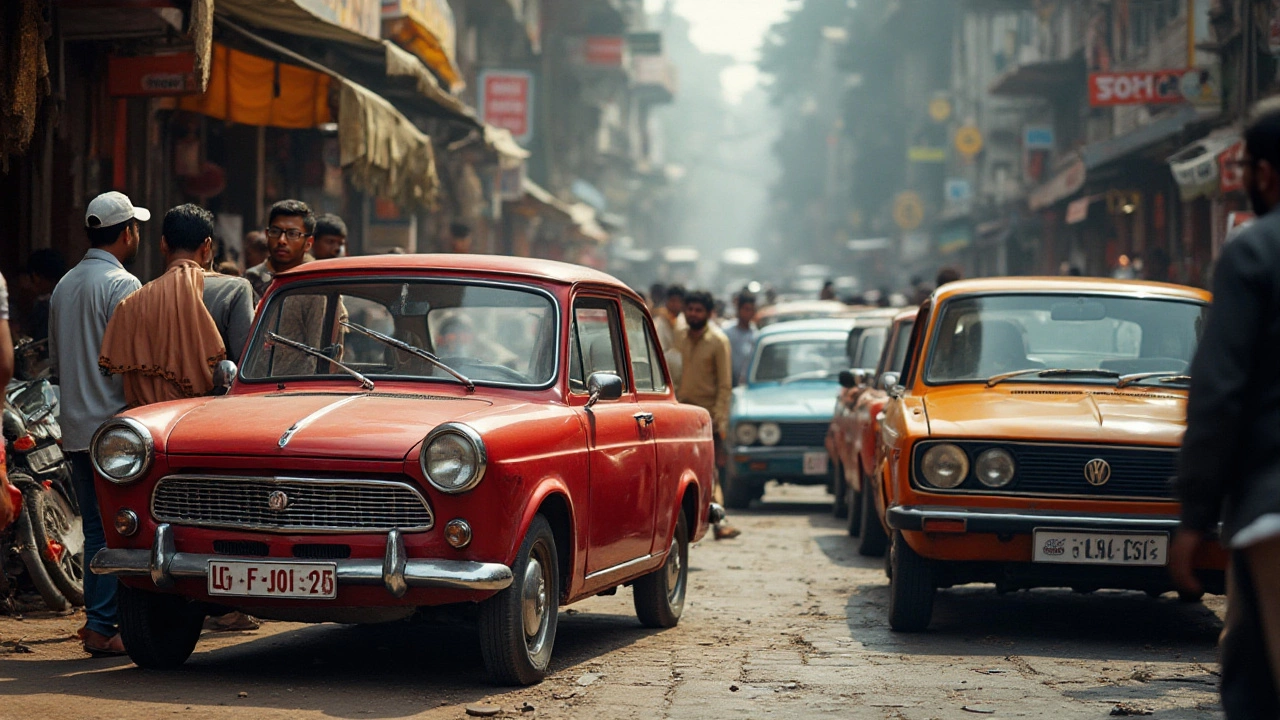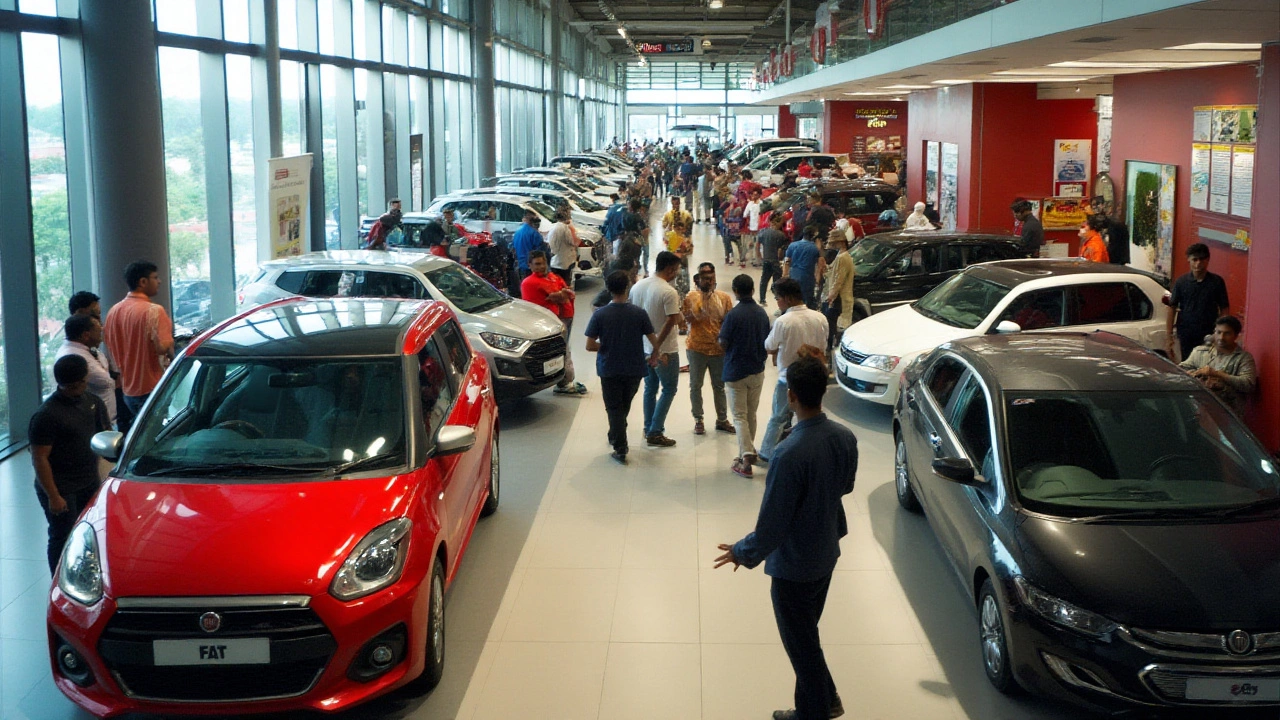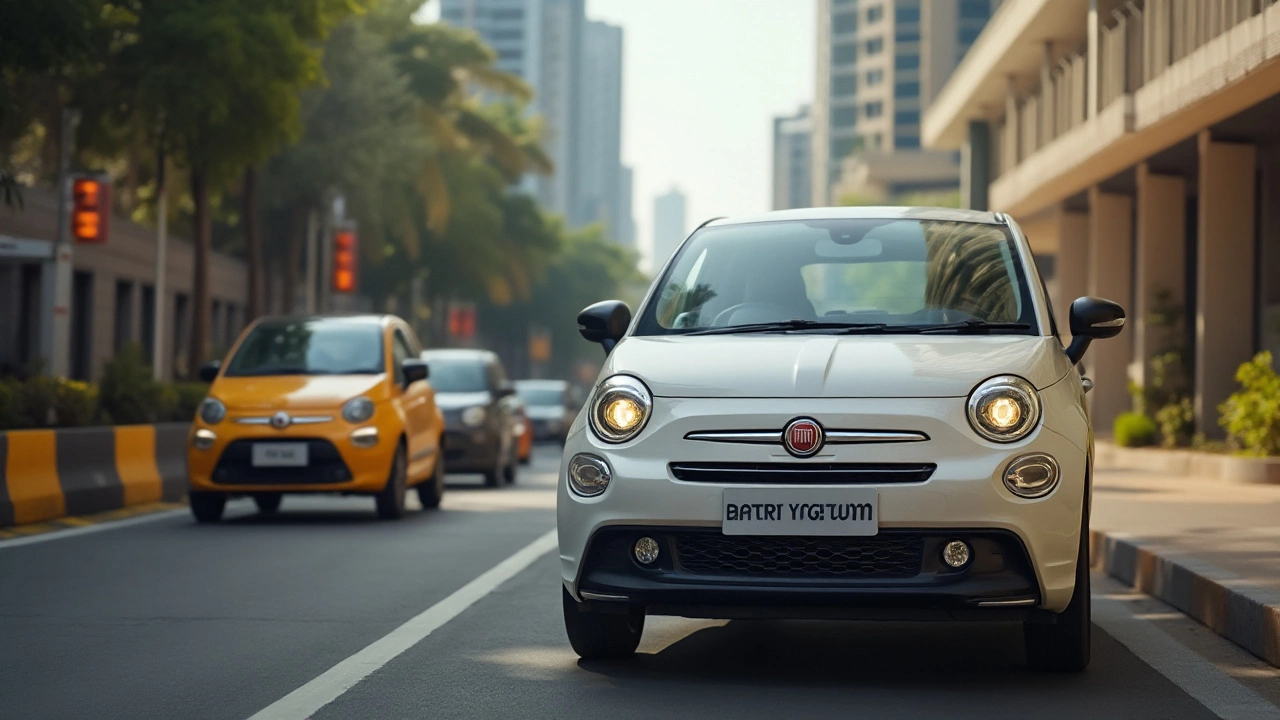 Jan, 25 2025
Jan, 25 2025
The departure of Fiat from the Indian market left many car enthusiasts and industry experts pondering over the reasons and implications behind this decision. For years, Fiat held a distinct place, known for its unique design and loyal fan base. Yet, the unpredictable roads of the Indian automobile market can be challenging to navigate.
The landscape of the automotive industry is ever-evolving, with consumer preferences shifting towards more fuel-efficient and tech-savvy vehicles. Fiat's classic models found it hard to compete in this environment. Dive into the dynamics that led to Fiat's exit and uncover the strategic errors that factored into their decision to leave.
- The Initial Appeal of Fiat in India
- Challenges in a Competitive Market
- A Shift in Consumer Preferences
- Regulatory Hurdles and Market Entry Barriers
- Fiat's Strategic Decisions and Missteps
- The Impact of Fiat's Departure
The Initial Appeal of Fiat in India
In the early years of its entry into the Indian market, Fiat made waves with its unique blend of European elegance and robust design. The brand's initial appeal lay in its iconic models that boasted a sense of heritage combined with modern style. A nostalgic aura surrounded Fiat vehicles like the Premier Padmini, reminiscent of an era where the car was not just a mode of transport but a symbol of status. This was a time when the Indian automobile landscape was dominated by a handful of players, and Fiat's offerings stood out for their distinct aesthetics and engineering marvels.
During the decades of 1960s and 70s, Fiat cars were among the most popular choices for urban dwellers across India. The company's collaboration with Premier Automobiles gave rise to models that were not only stylish but also known for their sturdy build and reliability. These cars were a fixture in Bollywood movies, adding to their allure and making them a cultural phenomenon. It was common to see Padminis zipping through the crowded streets of Mumbai, serving as the quintessential taxi cab and carving a niche in the collective psyche of the nation.
The journey of Fiat India was not just about cars, but it was also about the lifestyle they promoted. Owning a Fiat felt like becoming part of an exclusive club where panache met practicality. Its design ethos resonated with a generation that sought more than mundane functionality from their vehicles. In those early days, Fiat's unparalleled craftsmanship coupled with an element of Italian flair attracted a loyal customer base who appreciated the finer details in their cars.
"Fiat appealed to the nascent urban middle class who dreamt of belonging to a world beyond their immediate grasp," commented automotive historian Ramachandra Bhat. "It wasn't just about driving; it was about driving something unique, something that resonated deeply with personal identity."
However, the narrative was not just about aesthetics. Fiat delivered on performance, too, often being lauded for smooth rides and efficient engines. For many, the very name 'Fiat' became synonymous with trust and reliability. It was during these golden years that the brand's foundations were laid in the Indian market, and it enjoyed a sense of brand loyalty that few others could match at the time.
As the years went by, Fiat did face competition from emerging brands, yet their cars continued to enjoy patronage from a segment that valued tradition and longevity in a world that was slowly leaning towards change. As folks reminisce about those times, it is evident that Fiat's presence in India transcended mere business—becoming an integral part of many personal adventures and memories across generations.
Challenges in a Competitive Market
The Indian automotive market is like a bustling bazaar where various players vie for the attention of consumers who are becoming more discerning by the day. Fiat, with its long-standing heritage and global reputation, initially entered this market with optimism. However, the real challenge lay in competing against established brands like Maruti Suzuki, Hyundai, and Tata Motors, which had already cemented their positions by offering products tailored to local tastes, affordable pricing, and extensive service networks.
One significant hurdle was Fiat's limited product lineup. As other brands rapidly expanded their offerings, Fiat struggled to keep pace, maintaining a range that was often seen as stagnant. While their signature cars appealed to a niche audience, the lack of new models did little to capture the mass market. Coupled with a perception of high maintenance costs and lower fuel efficiency compared to compact cars offered by rivals, this led to dwindling sales figures.
It's worth noting the power of strategic partnerships and local collaborations in this field. Companies like Hyundai capitalized on joint ventures with local companies, enhancing their operational efficiency and distribution reach. Fiat's partnership with Tata, in contrast, had its own set of challenges. Although it brought initial success with models like the Linea and Punto, sales eventually plateaued without significant updates or innovations.
"The Indian car market is fiercely competitive. Without constant innovation and understanding of local needs, even established global players can find it difficult to succeed," observed industry expert Rakesh Kapoor during an automotive conference in 2023.
Pricing strategies also played a vital role. In a market intensely conscious of value for money, Fiat's pricing appeared less competitive. With an influx of affordable and feature-packed options from other manufacturers, Fiat's offerings seemed less attractive to cost-sensitive consumers. Add to this the challenge of limited service centers across the country, which further alienated potential buyers concerned about after-sales service.
Leaping into uncharted territory without deeply reading the customer's pulse and failing to innovate at the pace of the market can make survival tough. Fiat's exit from India serves as a lesson on the importance of adapting products and strategies to fit the unique fabric of local markets. As the dust settles, Fiat's legacy remains a topic of reflection in understanding the dynamics of the automobile industry in India.

A Shift in Consumer Preferences
The dynamic nature of consumer preferences in India has always been a critical factor for automobile manufacturers. As the millennium turned, the Indian car buyer began to evolve, seeking more than just basic transportation needs. The onset of the digital age and the rapid influx of technology meant that consumers now looked for connectivity and innovation even in budget-friendly models. Fiat, with its traditional design ethos, seemed to lag in incorporating these modern features that newer generations sought. As the desire for tech-savvy and fuel-efficient vehicles grew, companies like Maruti Suzuki and Hyundai seemed to strike the right chord with Indian buyers.
The comfort of a spacious interior, advanced infotainment systems, and superior safety features were becoming non-negotiable for urban families. Fiat, with strong European roots, found it challenging to cater to these specific demands within the budget constraints prevalent among Indian consumers. Notably, a Fiat model wouldn’t easily provide the mileage or low-maintenance cost that its competitors promised. This inclination towards cost-effectiveness has been consistently evident. According to a report by the Society of Indian Automobile Manufacturers, there was a significant rise in the sales of entry-level compact cars and SUVs, indicating a clear shift in preference towards vehicles that provided maximum value for money.
"The Indian consumer today is more informed and less brand-loyal, meaning manufacturers have to continuously innovate to capture their attention," said Anand Mahindra, a notable figure in the automobile industry.
Additionally, as the aspirations of middle-class Indians grew with increasing disposable income, the demand for luxury features in cars similarly ascended. This change was not lost on global automakers, who adeptly adapted and launched models tailored for the Indian market. Fiat, unfortunately, found itself caught in a strategic quagmire, torn between staying true to its heritage and pivoting to meet the relentless demands of a changing market. Often, models that found success elsewhere didn’t translate as effectively in India because they weren’t sufficiently tweaked for local tastes and needs.
In effect, this changing consumer landscape affected not just Fiat alone but signaled a broader need for automakers to study and adapt their product lines regularly. The fusion of affordability with features was a lesson learned well by those who have thrived in the market both domestically and internationally. As customers hungered for vehicles that represented a lifestyle choice rather than just a mode of transport, the challenge for manufacturers like Fiat was adapting swiftly and effectively without losing their core identity.
Regulatory Hurdles and Market Entry Barriers
When examining the retreat of Fiat from the Indian market, it's critical to delve into the intricate maze of regulatory hurdles and market entry barriers that played a pivotal role. These factors are often invisible to the everyday consumer but can have monumental impacts on a car manufacturer's capability to thrive. India's regulatory climate is known for its complexity, with shifting policies that can leave international companies scrambling to adjust their strategies. Each step from emission norms to safety standards requires adherence, and for companies like Fiat, missteps were costly. Implementing sudden regulatory changes has derailed plans for many, as adapting to new norms requires not only time but considerable investment.
Emissions standards in India have been evolving rapidly, aligning with global efforts to curtail pollution. The shift from Bharat Stage IV to Bharat Stage VI—leaping over Stage V entirely—necessitated major investments in technology and infrastructure. This leap required automakers to re-engineer engines and retrofit existing models, which was a formidable challenge for Fiat. For a company like Fiat, which had a significant part of its product lineup comprising older models, this regulation posed a challenge. The financial strain coupled with the pressure to innovate efficiently added to the mounting challenges faced by the brand.
Tata Motors' then-chairman, Ratan Tata, once noted, "Complying with regulatory norms quickly and effectively is a daunting task, and often not without its share of financial burdens." His words reflect the shared sentiment across the automotive sector, where strategic miscalculations in response to regulation can have long-term consequences.
Furthermore, obtaining permits and approvals has been a lengthy procedure overshadowed by bureaucratic red tape. Consider the disparities in regional rules, tariffs, and local content requirements—each state in India may have its own set of rules, adding layers of complexity. Meeting domestic production targets, an integral part of the Make in India initiative, meant reconfiguring operations and sourcing more products locally. While this initiative was aimed at boosting economic growth and employment, it often caught foreign manufacturers off guard. Meeting these expectations has stretched resources thin, forcing companies to reconsider their strategy.
The challenges weren’t solely from the regulatory side. Market entry barriers also presented significant hurdles. The Indian market is unique with its strong preference for specific car segments, often skewed towards budget-friendly compact cars. Competing against established brands that already had entrenched supply chains and brand loyalty took significant effort. Fiat's portfolio, which was more niche, found it hard to resonate with the broader consumer base. Pair this with a lack of expansive dealer networks compared to giants like Maruti Suzuki or Hyundai, and the struggle becomes even more apparent.
To encapsulate, Fiat's struggles in India offer a window into the complex world of regulatory challenges and market dynamics. It serves as a cautionary tale for other automobile manufacturers, emphasizing the need to balance compliance with strategic foresight. By understanding these barriers, companies can better equip themselves to navigate the unpredictable, yet promising Indian car market.

Fiat's Strategic Decisions and Missteps
Fiat's journey in the Indian automobile industry is a fascinating case of strategic decisions intersecting with market realities. When Fiat first entered the Indian market, it seemed poised for success with its iconic Italian design and recognition from decades of global presence. Yet decisions over time showed a disconnect between what the Indian consumer desired and what Fiat delivered. The brand primarily focused on its European lineup, believing the unique styling and engineering would capture the Indian populace. This strategy backfired as competitors like Maruti Suzuki and Hyundai, who tailored their offerings specifically for Indian roads and taste, gained the upper hand.
One crucial decision regarding the dealership network also had long-lasting effects. Fiat initially partnered with Tata Motors for its distribution, thinking it would help penetrate the market more rapidly by leveraging Tata's extensive reach. Unfortunately, this led to a muddled branding strategy where Fiat's identity was overshadowed by Tata's sales force, resulting in unclear messaging to the consumers. Critics felt this was a strategic misstep as Fiat failed to create a distinct brand identity, making it impossible to cultivate brand loyalty.
"In hindsight, Fiat's approach seems like it was driven by short-term gains instead of long-term vision," stated an industry analyst with the Financial Times.
The product development approach was another area where Fiat misjudged the dynamics of the Indian market. The absence of a solid lineup in the popular and rapidly growing segments like the compact SUV left a vacuum that competitors were quick to fill. While Fiat stubbornly stuck to models like the Punto and Linea, the market's demand was clearly shifting towards more spacious and versatile vehicles. With a lack of updated models and delayed launches, Fiat couldn't keep up with the pace set by other automakers investing heavily in research and development for the Indian audience.
Adding to the strategic challenges were issues with after-sales service and part availability. Many customers expressed dissatisfaction with the service quality and the delay in obtaining replacement parts. This dented consumer confidence significantly. Fiat's inability to address these customer care concerns highlighted the gaps in understanding the critical role service plays in purchasing decisions, especially in a market as diverse and competitive as India's. The failure to invest in consumer-oriented strategies and the neglect of after-sale mechanisms were stark mistakes in a market where word-of-mouth and trust are significant forces.
Lastly, Fiat's pricing strategy left much to be desired. Positioned as a premium brand, the cars were often priced higher than competitors offering similar features. This pricing misalignment meant that potential customers perceived other brands as offering better value for money, which steered buyers away from Fiat. Furthermore, the existing economic conditions, which saw increasing sensitivity to costs among Indian buyers, made it crucial for manufacturers to offer competitive pricing without sacrificing features. Fiat's management did not adapt swiftly enough to these changes, showcasing a critical strategic oversight.
These strategic decisions and missteps highlight that even established global brands need a deep local understanding and a tailored approach to conquer markets that have particular preferences and dynamics. For Fiat, the lessons learned from its exit reinforce the notion that success in the automobile industry demands not only engineering prowess but also agility in strategy and customer engagement.
The Impact of Fiat's Departure
The exit of Fiat from India not only surprised its dedicated fans but also signaled a shift in the automotive landscape of the country. With Fiat gone, the market lost a player that once championed classic European aesthetics blended with robust engineering. Its departure symbolized a retreat of sorts for traditional auto brands that couldn't align rapidly with the modern-day demand for tech-laden, fuel-efficient vehicles. As Fiat cars rolled off the streets, a sense of nostalgia quickly set in, particularly among the younger generations who grew up seeing models like the Punto and Linea zipping around town.
In Fiat's absence, the competitive dynamics among the remaining players adjusted significantly. Other manufacturers were quick to step into the gap left behind. Brands that could swiftly adapt to local preferences, especially those focusing on compact, efficient units with advanced features, gained a larger market share. These changes, however, meant that the distinct niche Fiat had once occupied was now a battleground of tech and efficiency rather than stylistic flair. As one analyst pointed out, "
Fiat's exit demonstrated the importance of not just introducing a quality product but ensuring it's the right fit for the market."
Market Dynamics Post-Exit
Post-Fiatal landscape brought some unintended consequences to the fore. With the brand no longer producing locally, a chunk of the workforce associated with Fiat's assembly and retail operations was displaced. These impacts, both direct and indirect, were keenly felt in regions where Fiat had its manufacturing footprint. However, the vacuum also opened opportunities for other players, leading to the expansion of facilities by competitors and the creation of new jobs, albeit with some market lag.Automobile industry experts opined that Fiat's departure served as a case study on the importance of local adaptation in product strategy. Businesses learned the hard lesson that relying solely on a brand's legacy wasn't a sustainable strategy in a rapidly evolving market like India. Despite Fiat's struggle for survival in India, enthusiasts held on to their beloved models, ensuring a thriving secondary market for spare parts and maintenance, keeping a part of Fiat's legacy alive on Indian roads.
Ripple Effects on Consumer Behavior
The departure of a foreign player of Fiat's caliber also subtly influenced consumer behavior. Buyers became more discerning, focusing on long-term maintenance, availability of parts, and the brand's commitment to the region. There was a perceptible shift in consumer loyalty, where brand legacy now played a background role when compared to real-time performance, durability, and provider support. Brands with an established service network gained traction, offering not just a vehicle, but a reliable partnership promise. Industry trends soon reflected this change, with analysts noting a heightened interest in innovation, service quality, and customer satisfaction metrics. This new paradigm ensured the availability of choices that could adapt to consumer expectations and economic ebbs and flows.